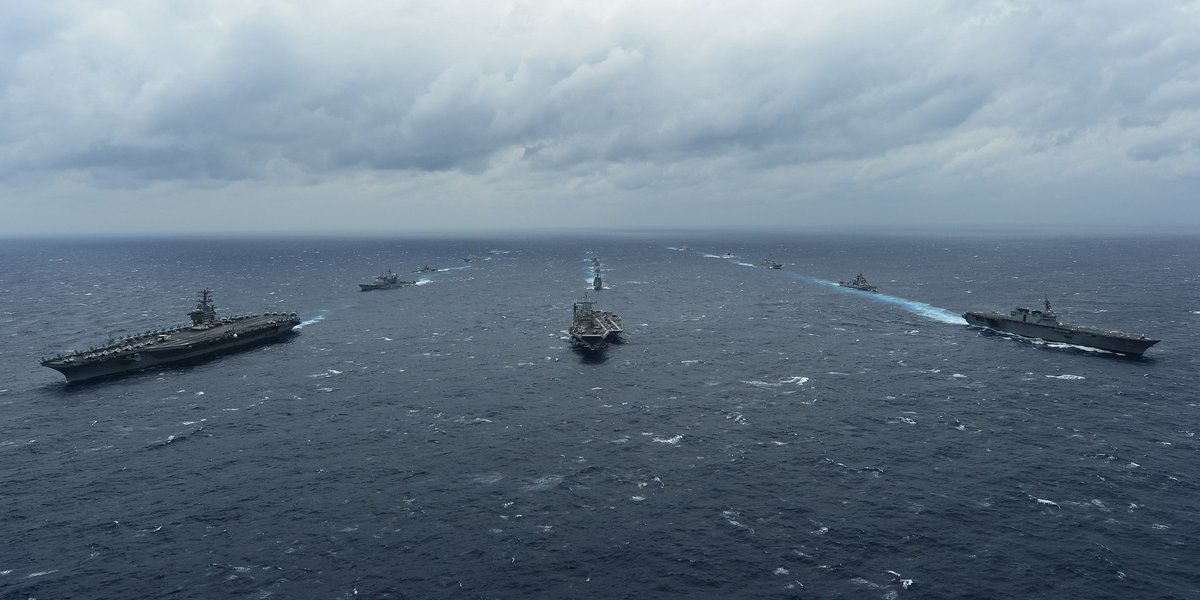
The Malabar exercise started in 1992 as a bilateral drill between the Indian Navy and the US Navy in the Indian Ocean. Japan became a permanent member of the exercise in 2015. (A file photo of Malabar 2017 naval drill)
NEW DELHI (PTI): In the midst of its bitter border standoff with China in eastern Ladakh, India will hold the first phase of the Malabar naval exercise with navies of the US, Japan and Australia from November 3 to 6 in the Bay of Bengal off Visakhapatnam coast, officials have said.
The second phase of the mega exercise is scheduled to be held from November 17 to 20 in the Arabian Sea, they said.
India has announced that Australia will be part of the Malabar exercise which effectively makes it a drill by all four member nations of the Quad or Quadrilateral coalition.
China has been suspicious about the purpose of the Malabar exercise as it feels that the annual war game is an effort to contain its influence in the Indo-Pacific region.
The invitation by India to the Australian Navy for the exercise came two weeks after foreign ministers of the 'Quad' member nations held extensive talks in Tokyo with a focus on enhancing their cooperation in the Indo-Pacific, a region where China has been expanding its military influence.
"The exercise will showcase the high-levels of synergy and coordination between the friendly navies in reflection of their shared values and commitment to an open, inclusive Indo-Pacific and a rules-based international order," said a military official.
The officials said the first phase of the drill would witness complex and advanced naval exercises, including surface, anti-submarine and anti-air warfare operations, besides cross-deck flying, seamanship evolutions and weapon firing exercises.
The exercise will be conducted as a "non-contact and at sea only" drill in view of the COVID-19 pandemic, they said.
The Malabar exercise started in 1992 as a bilateral drill between the Indian Navy and the US Navy in the Indian Ocean. Japan became a permanent member of the exercise in 2015.
The annual exercise was conducted off the coast of Guam in the Philippine Sea in 2018 and off the coast of Japan in 2019.
The Indian Navy will deploy a number of key platforms in the exercise which will include destroyer Ranvijay, frigate Shivalik, off-shore patrol vessel Sukanya, fleet support ship Shakti and submarine Sindhuraj.
In addition, advanced jet trainer Hawk, long-range maritime patrol aircraft P-8I, Dornier maritime patrol aircraft, and a number of helicopters will also be participating in the exercise, the officials said.
US Navy ship USS John S McCain, a guided-missile destroyer, Australian Navy's long-range frigate HMAS Ballarat with integral MH-60 helicopter and Japan Maritime Self Defence Force's JS Onami, a destroyer, will be among key platforms to be part of the first phase of the Malabar exercise, they said.
During the recent Indo-US 2+2 talks, US Defence Secretary Mark Esper welcomed India's invitation to Australia to join the Malabar exercise.
The evolving situation in the Indo-Pacific region in the wake of China's increasing military muscle flexing has become a major talking point among leading global powers. The US has been favouring making Quad a security architecture to check China's growing assertiveness.
India and China are locked in an over five-month-long bitter border standoff in eastern Ladakh that has significantly strained their ties. Both sides held a series of diplomatic and military talks to resolve the row. However, no breakthrough has been achieved to end the standoff.
After the invitation to the drill, Australian Defence Minister Linda Reynolds CSC said the Malabar exercise marked a "milestone opportunity" for the Australian defence force and that it will showcase the "deep trust" between four major Indo-Pacific democracies and their shared will to work together on common security interests.
For the last few years, Australia has been showing keen interest in participating in the exercise.
Defence and security ties between India and Australia have been on an upswing in the last few years.
In June, India and Australia elevated their ties to a comprehensive strategic partnership and signed a landmark deal for reciprocal access to military bases for logistics support during an online summit between Prime Minister Narendra Modi and his Australian counterpart Scott Morrison.
The Mutual Logistics Support Agreement (MLSA) allows militaries of the two countries to use each other's bases for repair and replenishment of supplies, besides facilitating scaling up of overall defence cooperation.
 Previous Article
Previous Article Next Article
Next Article













The Indian Air Force, in its flight trials evaluation report submitted before the Defence Ministry l..
view articleAn insight into the Medium Multi-Role Combat Aircraft competition...
view articleSky enthusiasts can now spot the International Space Station (ISS) commanded by Indian-American astr..
view article